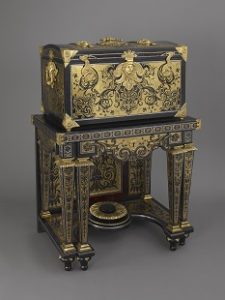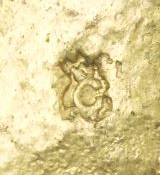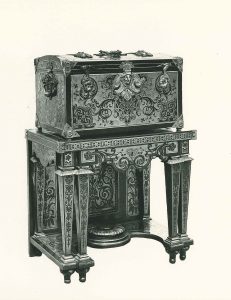Two Books of Swan-Marks, on Vellum
by Susan Odell Walker, Head of Public Services, The Lewis Walpole Library
Horace Walpole kept his most highly prized books in the “Glass Closet” in his library at Strawberry Hill. Among the books kept in that special case were “two books of swan-marks, on vellum: extremely rare” (Walpole, Description, 51). These books probably date to the sixteenth century, making them among the oldest in the Lewis Walpole Library’s collection. Neither volume bears any annotations by Walpole, and where Walpole himself obtained the books is unknown. They do not appear in the manuscript catalog of the Library, but Walpole makes of point of mentioning them in both of his editions of the Description of the Villa.
The volumes were sold at the 1842 sale of the contents of Strawberry Hill on day 6, lot 8, to Boone for £8.8.0 for Lord Derby of Knowsley Hall where they remained until they appeared at a Christie’s auction on the 19th October 1953, as lots 98-99. Maggs, the dealer who had prepared the Knowsley auction catalogs, bought the volumes for Lewis at the sale. They were among a couple of large groups of books Lewis acquired at the Knowsley Hall sales, and he resisted subsequent and repeated offers from another collector to buy these two volumes from him. A.R.A Hobson wrote in 1957 about the second volume’s binding, but the contents of both remain unexplored in any detail.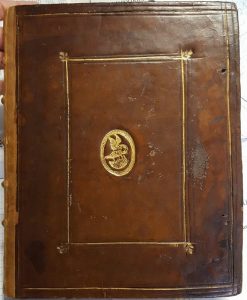
As W.S. Lewis (1969, lviii) wrote about Walpole’s library, “In the Glass Closet and E were the books that he liked best, his manuscripts and drawings and English antiquities. They had the quality that he valued above all others in his reading: They inspired visions.” Among the treasured items kept in the Glass Closet were antiquarian and genealogical manuscripts, the kinds of materials that appealed to Walpole for their historical associations. The Swan Marks books represent links to the long English tradition of prominent individuals keeping and marking mute swans, a privilege granted by the crown. The Walpole family, like many in Norfolk and the Fens, kept swans in times past, and in the second volume on page 45, row 1, position 3, is a swan mark labeled “Wallpoole.”

While Walpole doesn’t mention keeping swans himself, any visions inspired by the swan mark books would have been supported by the prospect from his window at Strawberry Hill where “Swans. . . are continually in view” (Walpole, Correspondence, 25:532).
The marking of the bills of mute swans to signify ownership of those birds found in England’s waterways dates back centuries, and the marks were registered with the crown. Swan marks books, registers, or rolls record the unique markings and owners’ names for identification. The marks themselves would have been cut or branded (MacGregor, 49) into the upper bills of the swans owned by eligible persons. The tradition of “swan upping” and annual census continues today, led by the Queen’s Swan Warden, the Swan Warden of the Worshipful Company of Vintners and that of the Worshipful Company of Dyers, although the birds are now marked with a leg band instead of cuts in the beaks.
A summary of the laws pertaining to marking and owning of swans, corresponding to those appearing in A New Law-dictionary: Containing the Interpretation and Definition of Words and Terms Used in the Law, can be found at the beginning of the second volume of swan marks in the LWL collection:
“No person may have a Swan Mark except he have land to the yearly value of five marks, and unless it be by grant of the King or his officers lawfully authorised or by prescription. Stat 22 Ed 4 c6
“Swan (cygnus) is a Noble Bird of Game: and a person may prescribe to have game of Swans within his manor as well as a Warren or Park. 7 Rep. 17 18
“A Swan is a Bird Royal, and all white Swans not mark’d, which have gained their natural Liberty, and are Swimming in an Open and common River, may be seized to the use of the King by his Prerogative. But a Subject may have a Property in white Swans not mark’d; as any man may have such Swans in his private Waters into an open and Common River he may retake them: though it is otherwise if they have gained their natural Liberty and Swim in open Rivers–without such Pursuit. Game Law par. 2 p. 152
“Stealing Swans marked and pinion’d or unmarked if kept in a Mote, Pond, or private River and reduced to Tameness, is Felony. HPC 68
“He that steals the Eggs of Swans out of their nests, shall be imprison’d a year & Day, and fined at the King’s pleasure. 11 Hen 7 C17
“Swanherd The King’s Swanherd, magister de ductus cygnorum. Pat. 16 R. 2
“No Fowl can be a Stray, but a Swan. 4 Inst. 280.” (Swan Marks, v. 2)
These passages appear in later cursive script on laid paper bound in before and after the main body of the book (49 2601 vol. 2) which otherwise consists of 67 pages of swan mark designs in black ink within stylized drawings representing swan bills, vertically oriented. Names of owners, written in secretary hand, appear above the marks. 54 pages contain designs, appearing in three rows of five designs per page. The remainder of the pages show the bill drawings without marks, presumably awaiting later additions. A comparison of the marks and names on pages 26 and 27 of this volume correspond precisely to those in the swan mark book in the collection of the British Library (Harley 3405).
The first, and smaller Walpole volume (49 2601 vol. 1) includes 30 pages of swan marks in black ink on orange-colored stylized drawings of bills, oriented horizontally, five to a page. There are four pages of manuscript waste bound at the front and back of the volume.
The first page of swan marks in volume 1 begins with one labeled Rex and one Regina. Subsequent designs are labeled with the names of other notable owners, including the Archbishop of Canterbury, the Bishop of London, the Abbot of Waltham, and more, as well as secular individuals.
A few of the relatively many extant examples of swan mark books are ones that can be found in collections of the British Library, The National Archives (UK), the Royal Society Archives, the Norfolk Record Office, the Bodleian Library, Chetham’s Library, and at the Society of Antiquaries of London. The Society of Antiquaries also holds N.F. Ticehurst’s archive on the history of swan marks.
Interest in books of swan marks and the tradition of swan upping predates Walpole and has continued throughout the nineteenth and twentieth centuries to today. Articles, observations, and inquiries about swan marks and swan upping in journals like Archaeologia and Notes & Queries, as well as in local history publications, are now joined by web pages, blog posts, and images on Pinterest boards.
Bibliography
Bromehead, J.M. “Memoir on the Regulations Anciently Prescribed in Regard to Swans,” in Memoirs Illustrative of the History and Antiquities of the County and City of Lincoln: Communicated to the Annual Meeting of the Archaeological Institute of Great Britain and Ireland, Held at Lincoln, July, 1848, with a General Report of the Proceedings of the Meeting, and a Catalogue of the Museum Formed on that Occasion, Royal Archaeological Institute of Great Britain and Ireland, 296-305. Lincolnshire: Office of the Institute, 1850.
Hobson, A.R.A. “Note 291. Bindings with the Device of a Pelican in its Piety.” Book Collector. Winter 1967. 16: 509-10.
Jacob, Giles, and John Holt. A New Law-Dictionary: Containing the Interpretation and Definition of Words and Terms Used in the Law …. London: Printed by H. Lintot (Assignee of Edward Sayer, Esq.), for R. Ware, A. Ward, J. and P. Knapton, 1744.
Lewis, Wilmarth Sheldon. “Horace Walpole’s Library.” In A Catalogue of Horace Walpole’s Library, by Allen T. Hazen. New Haven: Yale University Press, 1969.
MacGregor Arthur. “Swan Rolls and beak markings. Husbandry, Exploitation and Regulation of Cygnus olor in England, c. 1100-1900”. Anthropozoologica, 22: 39-68.
Royal Archaeological Institute of Great Britain and Ireland.“Memoir on the Regulations Anciently Prescribed in regard to Swans.” In Memoirs Illustrative of the History and Antiquities of the County and City of Lincoln: Communicated to the Annual Meeting of the Archaeological Institute of Great Britain and Ireland, Held at Lincoln, July, 1848, with a General Report of the Proceedings of the Meeting, and a Catalogue of the Museum Formed on that Occasion, 296-310. Lincolnshire: Office of the Institute, 1850.
Walpole, Horace. A Description of the Villa of Horace Walpole, Youngest Son of Sir Robert Walpole Earl of Orford, At Strawberry-hill, Near Twickenham: With an Inventory of the Furniture, Pictures, Curiosities, &c. Strawberry Hill: Printed by Thomas Kirgate, 1774-[1786].
———. “Letter to Horace Mann, Thursday, 30 September 1784.” The Yale Edition of Horace Walpole’s Correspondence, edited by Wilmarth S. Lewis. New Haven: Yale University Press, 1937-1983. 25.

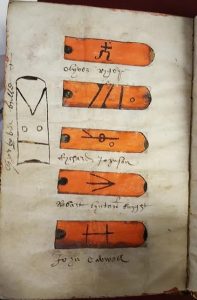

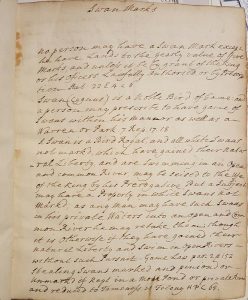
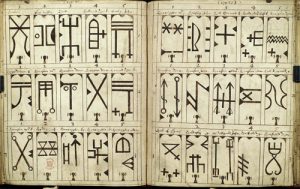
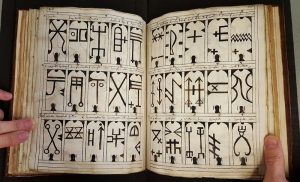

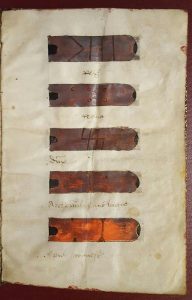










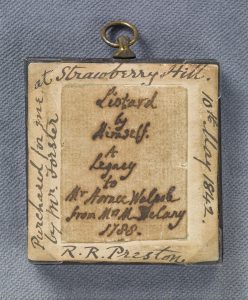
![The Cabinet of Miniatures and Enamels [John Carter] (in Folio 33 30 copy 11)](https://campuspress.yale.edu/walpole300/files/2017/09/lwlpr15618-rggmjt-231x300.jpg)
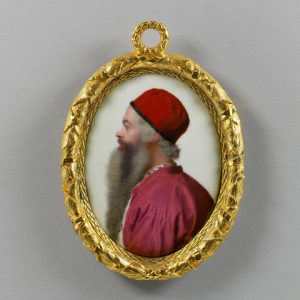


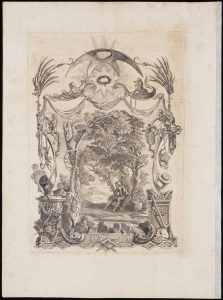


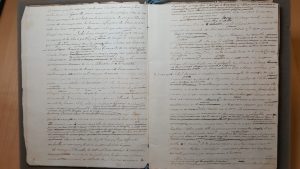

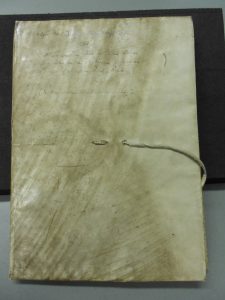

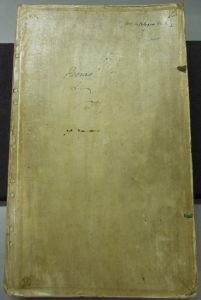
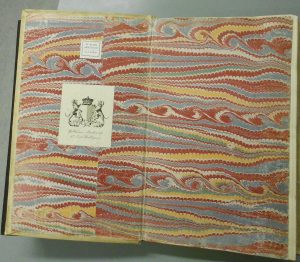
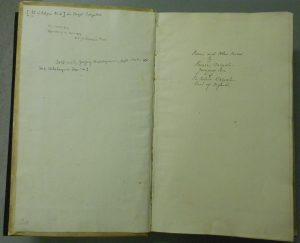


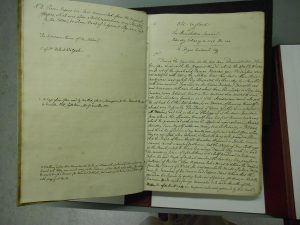







![[Lady Elizabeth Laura, Lady Charlotte Maria & Lady Anne Horatia, daughters to James late Earl of Waldegrave Knight of the Garter]](https://campuspress.yale.edu/walpole300/files/2017/08/lwlpr16495-q7mgs9-300x262.jpg)
